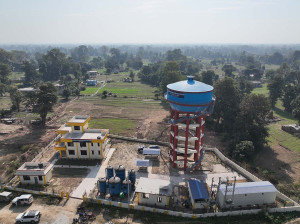Money
Nepal permits digital payments for third country transactions
Policy introduced on Friday will allow foreign citizens in Nepal to make payments for local purchases through a QR code.
Krishana Prasain
After India, Nepal’s central bank has opened the digital payment system for third countries, pending the completion of necessary arrangements by Nepal’s commercial banks for its formal enforcement.
The policy introduced on Friday, for the first time, will allow foreign citizens in Nepal to pay through a quick response (QR) code for purchases in Nepal.
Bankers say they will implement the system soon.
The central bank—Nepal Rastra Bank—by amending the inter-country payment system through QR code guidelines, has introduced a provision to allow foreigners to make payments while purchasing goods and services from Nepali traders in foreign currencies through the national payment switch, using the QR codes issued in their respective countries.
The funds will be received by the sellers' bank accounts in a convertible currency, said Dilli Ram Pokhrel, deputy information officer at the Nepal Rastra Bank.
“The central bank has now permitted Nepali banks to allow foreigners from all countries to make payments in Nepal using QR codes,” he said. “We have asked the banks to analyse, manage and mitigate the risk by themselves.”
Under the reciprocal basis, Nepalis travelling to third countries can also make foreign currency payments using the QR code through the national payment switch with the bank account associated with Nepali commercial banks, according to the amended guidelines.
Currently, a Nepali can get an exchange facility for up to $2,500 while travelling abroad.
“Once the digital payment system comes into effect, Nepali citizens can make payments using the QR code abroad,” said Pokhrel.
“This will eliminate the provision of carrying cash or paying through a card,” he said.
This means the limitation for each Nepali travelling abroad has been set at $2,500. “This provision, however, is not applicable for Nepalis in India,” said Pokhrel.
The central bank said that it has been studying the permissible spending limit for Nepalis in India.
From March 1, Indians are allowed to make payments for purchases through their mobile phones, marking a milestone in cross-border digital payment between Nepal and India.
Upendra Prasad Poudel, chairman of Nabil Bank, said since foreigners are allowed to make payments in Nepal using their Visa cards or Mastercards, the QR code system is a great leap forward to promote the digital economy.
“The QR codes system is practised globally. We, now, have to assess and analyse cyber security issues, identify risks, and monitor possible fraud and theft through system back-up,” he said.
“That is, we need a robust operating system.”
Poudel, who is also president of the Confederation of Banks and Financial Institutions Nepal, said the new system, once enforced, will connect Nepal to the international payment system.
“If Nepal can interlink the digital payment system with India, Nepal’s largest trading partner, it would be more beneficial,” said Poudel.
Nepal and India have a total trade amounting to Rs1.13 trillion, out of the total annual trade amounting to Rs1.76 trillion.
The central bank has also made it easy to send remittances between Nepal and India.
According to the amended guidelines, Indian workers in Nepal, who have accounts in Nepali banks, can send money through e-banking, interbank payment, mobile bank and QR code to Indian banks and financial institutions through the national payment switch.
The central bank has set a limit of INR15,000 per day and INR100,000 per month for person-to-person transfers.
Similarly, in the same way, Nepali citizens who have accounts in Indian banks and financial institutions can send remittances to Nepal using e-banking, interbank payment, mobile banking and QR codes.
Currently, there is an Indo-Nepal Remittance Facility, a cross-border remittance scheme to transfer funds from India to Nepal (one-way only), launched by the Reserve Bank of India in May 2008 to provide a safe and cost-efficient avenue to migrant Nepali workers in India to remit money back to their families in Nepal.
Under the scheme, Nepalis in India can remit up to INR200,000 per transaction to the beneficiary residing in Nepal, provided the sender maintains an account with any National Electronic Funds Transfer enabled bank branch in India. Walk-in and non-customers can remit up to INR50,000 per transaction to beneficiaries residing in Nepal.
In August 2021, the scheme was enhanced to boost the trade payments between the two countries, and to facilitate payments relating to retirement, pension, etc., to Indian army veterans in Nepal.
The remittance from India was allowed only through the SBI Bank, India, but now, Nepalis can send remittances from any bank in India using the digital system, said Pokhrel.
“It may take a few months for the banks to conduct risk management and analysis. After that we need to tie up with the QR code service merchants in the country to begin the digital transactions,” said Poudel of the Nabil Bank.




 16.12°C Kathmandu
16.12°C Kathmandu













